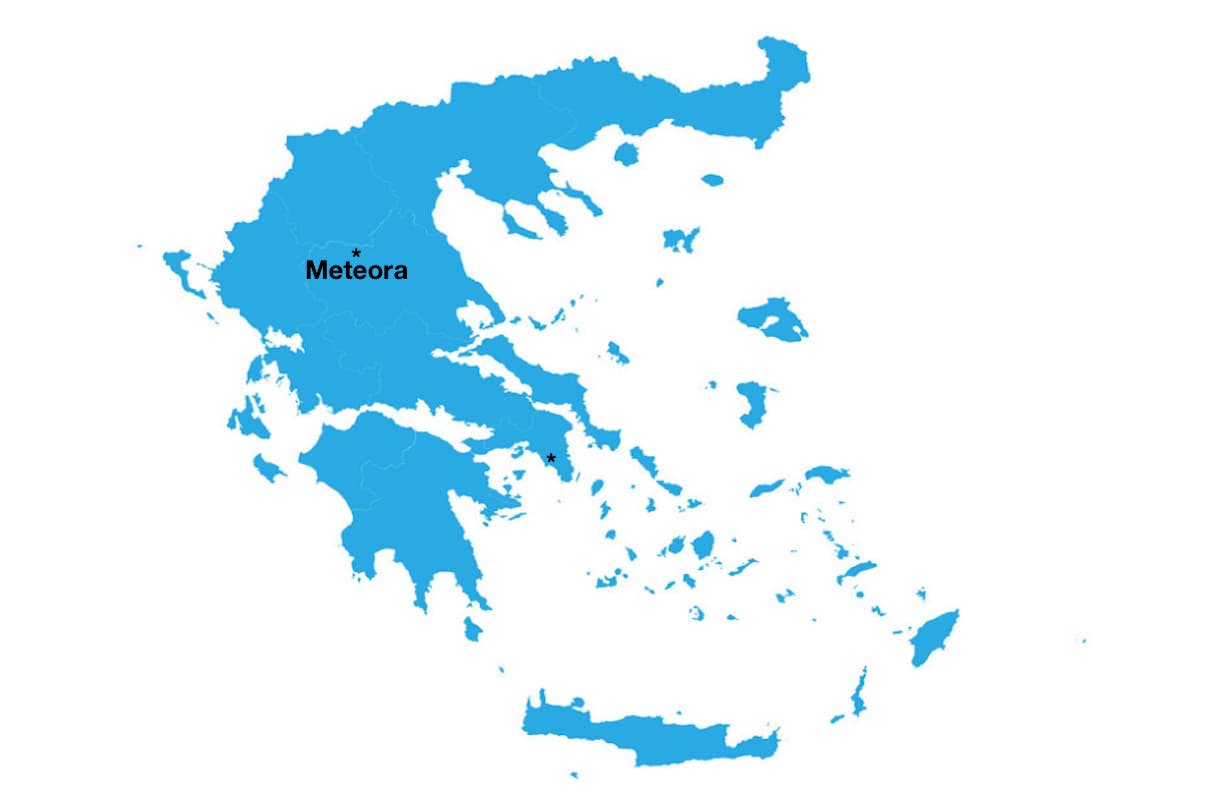METEORA PRIVATE TOURS
World Heritage Sites by Private Tours Greece
Athens to Meteora private tours, and World Heritage Sites of Greece on guided luxury private tours
Kalambaka - Kastraki - Meteora Private Tours
Meteora Private Tours, organized by Private Tours Greece, takes you to Meteora, located in Thessaly, Greece, a truly remarkable destination shaped by the forces of nature. Meteora is uniquely sculpted by nature, with monasteries built on magnificent cliffs that rise to 600 meters. Its towering cliffs provide a breathtaking backdrop for the monasteries, which have stood for centuries. These monasteries are architectural marvels and hold great cultural significance. Recognizing their exceptional value, UNESCO designated the monasteries of Meteora as a unique cultural heritage phenomenon. Since 1988, they have been proudly included on the prestigious UNESCO World Heritage List. Nestled beneath the majestic rocks lies the charming village of Kastraki, offering visitors a picturesque setting to explore. With its traditional houses and narrow streets, Kastraki exudes a quaint and authentic atmosphere. Just a stone's throw away, Kalambaka provides additional tourist amenities and services, including a wide range of excellent hotels and beautiful guesthouses. Visitors can enjoy comfortable accommodations while immersing themselves in the area's natural beauty and cultural heritage. Our Meteora private tours offer a unique experience combining awe-inspiring landscapes and rich cultural heritage.
Meteora
The origin of the rare geological phenomenon of the towering rocks in Meteora remains a mystery. Various theories have been proposed, but none have been proven. These magnificent rocks have proudly stood for thousands of years, providing a breathtaking backdrop for the 24 monasteries built atop them more than six centuries ago. The first inhabitants of Meteora were monks who sought solitude and spiritual contemplation in the caves of these rocks. The earliest recorded hermit to occupy a cave was Barnabas in 985 AD. As time passed, more monks arrived, and in the mid-14th century, they constructed a small church. In 1382, the monk Athanasios, hailing from Mount Athos, established the grand monastery of Magalo Meteora on one of the towering pinnacles. Inspired by Athanasios, twenty-three additional monasteries were built, each perched precariously on the rocky outcrops. However, by the 19th century, many of these monasteries had fallen into ruins. It was not until the 1920s that steps were carved into the rocks, making the remaining six monasteries more accessible to visitors. Recently, a religious revival in Meteora has led to numerous monks and nuns returning to the monastic community. Meteora continues to captivate visitors today with its awe-inspiring natural beauty and spiritual significance.
Monastery of Megalo Meteoro
Also known as the Great Meteoron, this remarkable monastery holds a significant place in history as the first and highest monastery in the region. It stands proudly at an impressive altitude of 623 meters. Its foundation dates back to 1382 when it was established by Athanasios, a devout monk who initially resided in a humble cave. Athanasios' dedication to his spiritual journey and the setting of this sacred place are inspiring. Within the monastery's grounds, the main church serves as a final resting place for Athanasios. This adds a profound reverence and sanctity to the church, making it a focal point for pilgrims and visitors alike. The monastery's architecture and serene surroundings enhance the spiritual atmosphere, creating a tranquil haven for contemplation and worship. Over the centuries, the Great Meteoron Monastery has withstood the test of time, preserving its rich heritage and attracting countless individuals seeking solace and spiritual enlightenment.
Varlaam Monastery
Varlaam has a fascinating history dating back to 1350. The monastery was named after the first hermit to inhabit the rock, Varlaam himself. In his time, Varlaam constructed three magnificent churches, a humble room for himself, and even a water tank to sustain his solitary life. However, despite his efforts, no other monks were drawn to join him in his spiritual journey. After Varlaam's passing, the site remained abandoned for two centuries. It wasn't until 1517 that the monastery saw a revival, thanks to the efforts of two monks from Ioannina named Theophanes and Nektarios. These dedicated individuals took it upon themselves to re-establish the monastery, breathing new life into the sacred place. The monastery began flourishing again with their arrival, attracting monks from far and wide who sought solace and spiritual enlightenment. Theophanes and Nektarios worked tirelessly to restore the monastery's buildings and expand its facilities, ensuring it could accommodate the growing number of monks seeking refuge there. Their dedication and perseverance paid off, as Varlaam Monastery became a thriving center of spirituality and learning. It became renowned for its beautiful architecture, intricate frescoes, and valuable religious artifacts. Pilgrims and visitors worldwide were drawn to the monastery, eager to witness its rich history and experience its serene atmosphere. To this day, Varlaam Monastery is a testament to the enduring spirit of its founders, Varlaam, Theophanes, and Nektarios. It serves as a place of tranquillity and contemplation, offering a glimpse into the past while continuing to inspire and uplift those who visit.
Rousanou Monastery
The Rousanou Monastery, constructed in 1545 by Maximos and Ioasaph of Ioannina, is a testament to Meteora's rich history. Although the exact origin of its name remains uncertain, the monastery is devoted to the veneration of Saint Barbara. During the tumultuous Second World War, Roussanou Monastery, like its counterparts in Meteora, was a victim of looting and destruction. However, despite its hardships, the monastery persevered and thrives today. Presently, the Rousanou Monastery is under the stewardship of a community of dedicated nuns. It is worth noting that among the six monasteries in Meteora, two are exclusively inhabited by nuns, adding a unique dimension to the spiritual landscape of the region. These nunneries further enrich Meteora's cultural and religious tapestry, attracting visitors from far and wide who seek solace and enlightenment in this awe-inspiring setting.
St Nicholas Anapafsas Monastery
The Monastery of St Nicholas Anapafsas, founded in the 14th century, holds a certain air of mystery regarding its namesake. Despite its long history, the exact origin of the name remains unclear, leaving historians and scholars intrigued. However, what is undeniably clear is the monastery's claim to fame – its breathtaking frescoes. Painted by the renowned Cretan artist Theophanes Strelitzias in 1527, these frescoes are a testament to the artistic brilliance of the time. Theophanes Strelitzias, known for his mastery of Byzantine art, left an indelible mark on the monastery's walls, showcasing his exceptional talent and attention to detail. Interestingly, the monastery's journey has been challenging. After flourishing for centuries, it faced a period of abandonment that lasted for a staggering 60 years, starting from 1900. During this time, the monastery stood silent, its halls echoing with the absence of monks and visitors. In the 1960s, the Greek government recognized the historical and cultural significance of the Monastery of St Nicholas Anapafsas and took the initiative to restore it to its former glory. This restoration effort breathed new life into the monastery, allowing it to serve again as a place of worship, contemplation, and artistic appreciation. Today, visitors worldwide can marvel at the exquisite frescoes adorning the monastery's walls, which transport them back to the 16th century. The Monastery of St Nicholas Anapafsas stands as a testament to the enduring power of art and history and the dedication of those who strive to preserve our cultural heritage.
St Stephen Monastery
The Monastery of St Stephen, founded in the 14th century by St Antoninus Cantacuzene, holds a fascinating historical connection. St Antoninus Cantacuzene, believed to be the son of the Serbian ruler Nicephorus II of Epirus, established this monastery in 1400. The monastery's Katholikon, or main church, is dedicated to St Charalambos, a revered figure known for his association with preventing illness. Tragically, during the Second World War, much of the monastery suffered severe destruction. However, despite the devastation, the Monastery of St Stephen remains a testament to the resilience and enduring spirit of the monastic community. The Monastery of St Stephen is one of the two nun-run monasteries in the Meteora region. This unique characteristic adds to the monastery's significance and provides a distinct perspective on monastic life in the area. The presence of nun-run monasteries contributes to the diverse religious landscape of Meteora, offering visitors a glimpse into the different traditions and practices within the Orthodox Christian faith.
Holy Trinity Monastery
The Holy Trinity monastery, founded by the monk Dometius in the 15th century, holds a rich history and remarkable artistic treasures. One of its notable features is the stunning 18th-century murals adorning its walls, skillfully created by the talented brothers Antonios and Nikolaos. These intricate artworks add a touch of beauty and spirituality to the monastery's interior. Visitors must ascend a challenging path of 140 steps meticulously carved into the rock to reach the monastery. As you make your way up, you will pass by the church of St John the Baptist, which boasts captivating murals dating back to 1682. These ancient paintings provide a glimpse into the region's artistic and religious heritage, offering a fascinating insight into the past. The journey to the Holy Trinity monastery is both a physical ascent and a spiritual one. The serene surroundings and the architectural marvels along the way create a sense of awe and reverence, making visiting a genuinely memorable experience for all who venture there.

Meteora
UNESCO has characterized the monasteries of Meteora as a unique phenomenon of cultural heritage and included them in the list of UNESCO World Heritage Sites in 1988.





